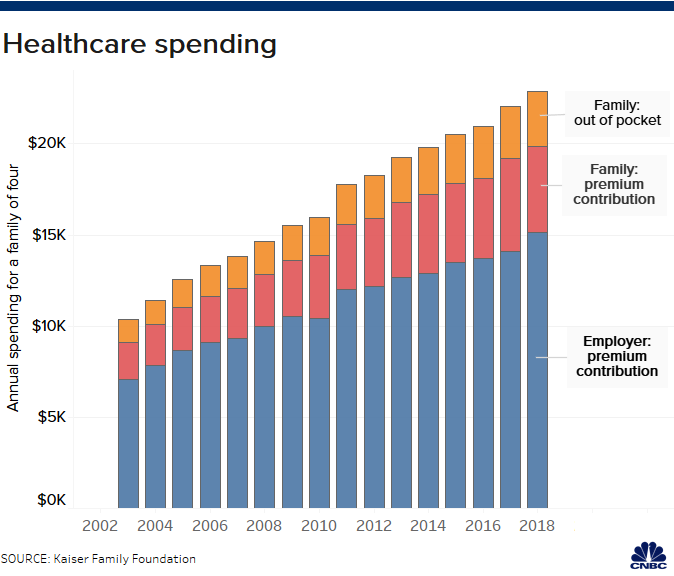The state of health insurance in the United States and in California, in particular, is always shifting and evolving. While this is true, there are some trends that have stayed constant for most of the last 20 years is the inexorable rise in monthly health insurance premiums. This has been especially marked since 2009.
In 2020 this trend will be no less significant. The federal government estimates an increase of approximately five percent over the average monthly costs just five years ago.
Here is a chart from CNBC’s website illustrating this ongoing trend:
CNBC also noted the following points:
- Average total health spending for a family of four with workplace coverage hit $7,726 in 2018, a 67% increase from 10 years ago, according to the Kaiser Family Foundation.
- Expenses have also gone up for employers, who spent an average of $15,159 in premiums to cover a family of four.
- Medical coverage costs have outpaced wage growth: Families’ costs are up 67% compared to a decade ago, while wages have increased 26%, according to the foundation.
Along with this not-so-great outlook is another negative trend, and that’s the seemingly increase in shortage of doctors.
Why Can’t I Find a Doctor?
A somewhat disturbing development that will become even more impactful going into 2020 is the lack of doctors, specialists and other skilled medical personnel. Although actual numbers are hard to pin down as this is a largely dynamic situation, anecdotal evidence is becoming increasingly common.
One family in Sonoma County, for example, enrolled with a new health insurance provider after the husband changed jobs. They chose a specific health care institution since this was this network they had been part of previously.
However, their preferred care provider (PCP) had unexpectedly moved on after having been their doctor for less than a month. He was the second doctor they had been assigned by their health care provider after their long-time doctor had retired a year earlier. Now they needed to find a new doctor.
After checking with six different campuses throughout the county, they finally succeeded in securing the services of a PCP in a town 15 miles away. However, this doctor was already booked out three months so their “new patient” visit would have to wait.
An article in the Los Angeles times reports that,
“California will be short about 4,100 primary-care doctors by 2030, according to a recent report from the California Future Health Workforce Commission, a blue-ribbon panel co-chaired by University of California President Janet Napolitano and Lloyd Dean, chief executive of Dignity Health.”
This is creating serious issues for hospitals, patients and remaining doctors and nurse practitioners. The reasons for this increasing shortage are numerous. According to a post at CalMatters.org,
“California is facing a growing shortage of primary care physicians, one that is already afflicting rural areas and low-income inner city areas, and is forecasted to impact millions of people within ten years. Not enough newly minted doctors are going into primary care, and a third of the doctors in the state are over 55 and looking to retire soon, according to a study by the Healthforce Center at UC-San Francisco.”
Low acquisition of new doctors and high attrition through retirement makes for distressing numbers when it comes to providing good health care.
The same article goes on to state that, “That means by 2030, the state… could be down by as many as 10,000 primary care clinicians, including nurse practitioners and physician assistants.” Regions such as the Central Valley, Central Coast and Southern Border region, as well as most rural areas will be hit especially hard.
A Positive Trend for Health Insurance in 2024
Technology has always played a vital role in healthcare and in the health insurance industry, as well. Today, outlier technologies promise to take up a more prominent role in the very near future.
According to a blog post at HealthAffairs.org,
“In the consumer markets, technology companies have started dipping their toes into the waters — to manage the flow of health care information in the case of the Apple Health Records platform, to connect patients to providers in the case of Uber and Lyft, and to bring the Prime buying experience to consumer medical products in the case of Amazon buying PillPack and selling common durable medical equipment through its online marketplace.”
Along with these developments, artificial intelligence, or AI, is being implemented in a widening scope of physician-led functions, according to the post, with the goal of streamlining and improving the overall tasks, and “to guide attending physicians toward evidence-based care decisions, alert them to data and research they may not have seen, or catch potential safety issues, such as duplicative treatments or medication interactions.”
WorkWith Health Insurance Professionals to Stay on Top of the Trends
J.C. Lewis Insurance Services is a family-owned and operated California health insurance agency licensed to do business in California. We specialize in medical insurance plans for Small Businesses, Individual and Families, and people with Medicare. At J.C. Lewis Insurance, our agents are licensed by the state of California and are certified to sell policies through Covered California. In addition, we offer accountability, explanations, and over 60 years of experience in the insurance industry. Contact us today at 866-745-9555 or fill out our online contact form.




